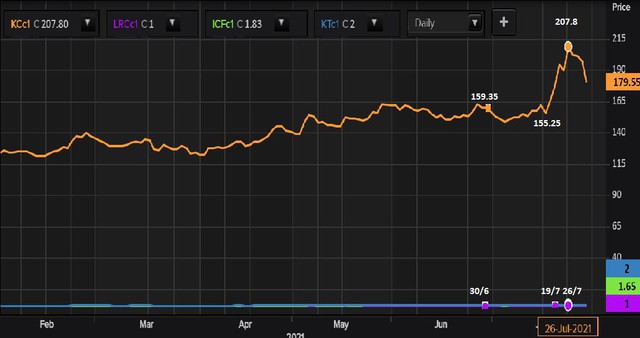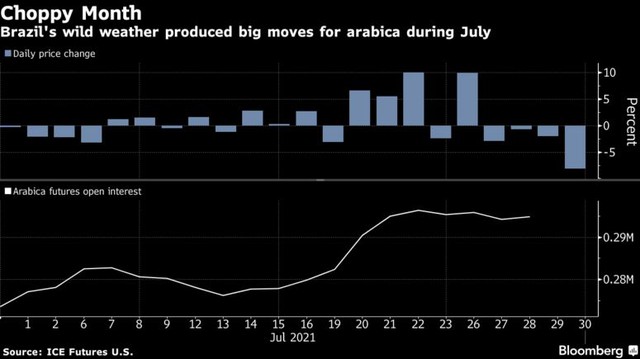The last session of July (July 30), the price of arabica for September futures on the New York Stock Exchange fell 16.95 cents, or 8.6%, to $1.7955/lb, far from the peak near 7. year achieved last week (above $2). This is the biggest drop since March 2008.
Robusta for delivery of the same term on the London floor this session also fell $ 99, or 5.3%, to $ 1,786 / ton. The reason is because the latest frost on the night of July 29 covered about 80% of the south of Minas Gerais, Brazil’s top coffee-producing region, but the impact was negligible.
Despite the sharp drop in this session, arabica prices are still up 12% in July and up 55% from a year ago, as adverse weather reduces production in 2021 and is expected to continue to affect production next year.

Price movement of arabica over the past year
Notably, in just the past 2 weeks, the price of arabica coffee has recorded many historical record milestones, and all of those extremely unusual fluctuations are related to the weather in Brazil, where consecutive frosts occur. produced in recent weeks causing severe crop damage, and with such extreme weather forecast to continue in the coming days, the risk of reducing global coffee supplies not only this year but in the future. for many years, because frost damages young coffee trees.
The sub-zero temperatures “defoliate and even kill young trees,” said analyst Carlos Mera of Dutch commercial bank Rabobank, which invests heavily in the agricultural sector. plan in the future.
That’s not to mention the possibility that the drought in Brazil will continue for many months, because meteorologists predict a high probability of this year’s La Nina weather phenomenon – which will make the rains not come in January. 9 as usual.
It should be known that the world’s largest coffee producing country suffered a historic drought earlier this year, severely affecting the crop.
From July 19 to now, coffee prices have continuously set records
July 19: September arabica futures rose more than 6% to a near 2-month high ($1,6610/lb); robusta also surged to a 3-year high ($1,793/ton).
July 20: Arabica prices hit their highest level since late 2016 ($1.7755/lb); robusta is the highest in 3 years.
July 21: Robusta prices increased by more than 10% to the highest since November 2014 ($1.95/lb), bringing the increase in just 3 sessions to nearly 21%; robusta also hit a 3.5-year high ($1,885/ton).
July 22nd: The price of arabica for September futures exceeded the threshold of 2 USD, reaching 2,0950 USD/lb; robusta to the highest level in nearly 4 years ($1,993/ton).
July 26: Arabica prices hit a 7-year high (US$2,1520/lb), investors scrambled to buy on fears of severe damage to Brazil’s crop.
July 30: September arabica futures fell 8.6% (to $1.7955/lb); robusta fell 5.3% (to 1,786 USD/ton).

Arabica prices fluctuated wildly in July due to extreme weather in Brazil.
Meanwhile, world coffee demand is increasing as global economies reopen. Arabica coffee is mainly used in cafes and restaurants, while robusta coffee is often used in instant coffee products.
The International Coffee Organization (ICO) in its report published in July 2021 has revised down its forecast for a global oversupply of coffee this crop year, although it has raised its forecast for an oversupply in the last crop. ends in June).
Accordingly, ICO estimates that in crop year 2020/21, the world has a surplus of 2.3 million bags of coffee, higher than the previous forecast of 2.01 million bags, mainly due to reduced consumption. That puts consumption at 167.20 million bags, slightly down from 166.58 million bags in the May assessment, and also lower than the 168.5 million bags consumed before the pandemic.
The ICO expects production from many countries, especially Brazil, to decline in the 2021/22 season, while consumption continues to recover as anti-Covid-19 restrictions are eased and the economy recover again. However, the ICO did not give a specific forecast of the shortage in the 2021/22 crop year.
In the context that Brazil’s coffee production is forecast to drop sharply and the demand of processors may partially shift from arabica to robusta, supply from Vietnam is again difficult due to the outbreak of the Covid-19 pandemic and the situation. severe lack of containers.
Shipping a container from Vietnam to Europe now costs up to 10,000 USD, 6-7 times more expensive than a year ago.
Some Vietnamese coffee exporters said that Vietnamese businesses and coffee growers have not benefited much from the recent sharp increase in coffee prices because coffee growers have sold most of their coffee, businesses are now want to buy is no longer significant. On the other hand, high transportation costs have discouraged coffee traders from signing contracts.
Vietnam’s coffee exports in the first 7 months of this year are estimated to decrease by 9.3% over the same period last year, to 953,000 tons, equivalent to 15.8 million 60 kg bags; estimated turnover decreased by 1.7% to 1.25 billion USD.
With the current difficulties and the possibility of their impact, the forecast of coffee prices in the coming time will remain high.
Chicago-based Hightower said: “Brazilian production in the upcoming 2022/23 has clearly been reduced due to the cold weather in July. Therefore, traders can take advantage of the drop in coffee prices to buy, before prices go up again.”
References: Nasdaq, Bloomberg, Reuters
